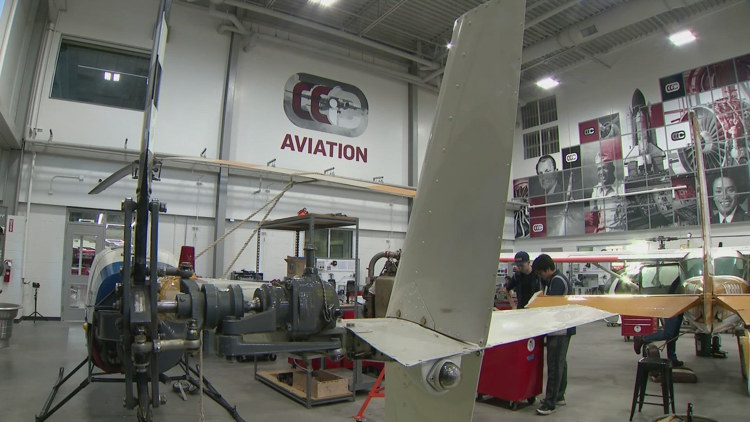[ad_1]

Experts say the number of airline mechanics needed to work on planes has been down for decades and they predict the problem will only grow.
CENTENNIAL, Colo. — The aviation industry is dealing with shortages including pilots and aircraft mechanics. Experts say the number of airline mechanics needed to work on planes has been down for decades and they predict the problem will only grow.
But school programs are helping to fill that gap.
This year, Cherry Creek Schools expanded its high school program training future aircraft mechanics to a three-year program, giving students the training and qualifications they need to get a job fixing planes right after graduation.
Inside Cherry Creek Innovation Campus (CCIC), senior Izzy Mitchell is focused on tightening a propeller. It’s part of the classroom curriculum for her course in powerplant aircraft mechanics.
“We’re learning a lot about the engines and how they work, like carburetors,” Mitchell said.
She hopes to fly planes one day.
“I figured, if I know how to fly a plane, I probably should know how to be able to fix it,” Mitchell said.
Her teacher, Ty McNew, spent years working on F16s in the military. He’s now passing on his knowledge of planes by teaching the next generation of aircraft mechanics.
“We bring in real airplanes, real helicopters, real test equipment and we try to teach them the latest and greatest of whatever the industry is seeing at this time,” said McNew, aviation powerplant instructor at Cherry Creek Innovation Campus.
Greg Feith and John Goglia, aviation experts, say the aviation industry has been short of aircraft mechanics for decades now.
“Over 20 years ago. We knew in the late 90s, we knew we were going to have a shortage,” said Goglia, former NTSB board member, former aircraft mechanic and current adjunct professor at Vaughn College of Aeronautics. “All those years, we had maintenance people retiring. So we have maybe close to 20 years of retirement without a good backfill.”
“You don’t have enough mechanics to fix airplanes, those airplanes don’t go anywhere,” said Feith, 9NEWS aviation expert.
That’s a problem that Goglia said is only going to grow.
“One major airline in the U.S. has about 14,000 mechanics employed,” Goglia said. “The average age of that 14,000 is almost 59 years old, which means that airline is going to have to replace 50% of their workforce in the next five years [or] six years.”
“So if we can help fill that gap and fill that void then obviously that’s the ultimate goal here in this class,” McNew said.
CCIC students start in as sophomores and with every year and every course, they have to pass tests through the FAA to move forward.
“After the third year, the kids will get an FAA endorsement and they’ll have their airframe and powerplant which is the endorsement you need to go work for any airline, air medical, general aviation,” McNew said.
Those qualifications are something Mitchell knows can help her career take off.
“It just gives more options for you to like think of in your future,” Mitchell said.
CCIC has a waiting list of roughly 90 kids hoping to get a spot in the aircraft mechanics program. Earlier this month, voters approved a bond that will allow them to expand the program and bring in more students.
McNew said almost every week, CCIC has school districts come to tour the program to see how they can bring something like this to their classrooms. It won’t stop the shortage of aircraft mechanics, but it can help.
[ad_2]
Source link







